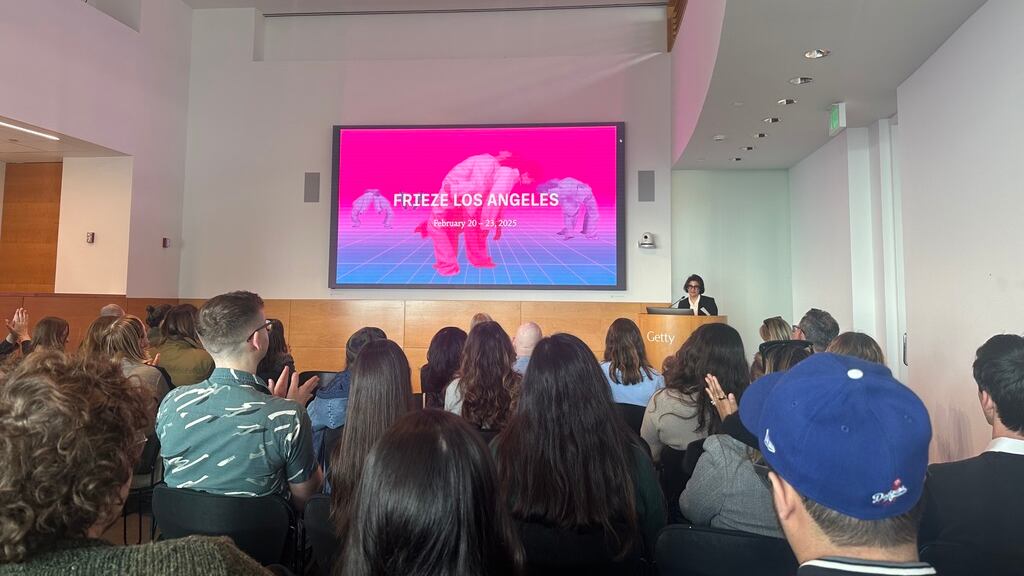Frieze Los Angeles, a global contemporary art fair, spotlights two South Central artists in its press preview a week before the fair welcomes international gallery giants, celebrities and locals to Santa Monica.
With global lead partner Deutsche Bank, Frieze L.A. returns for its sixth rendition of its February weekend of contemporary art. Frieze, originally launched as a magazine in 1991, hosts contemporary art fairs all over the world, from London to Seoul.
Christine Messineo, Frieze’s director of the Americas; Essence Harden, Frieze’s FOCUS curator; and Casey Fremont, the director of the Art Production Fund, spoke to the press at the Getty Center on Feb. 11, highlighting two artists from South Central who will exhibit at the fair Feb. 20 to 23.
In 2019, Frieze launched its FOCUS section, which highlights new galleries (less than 12 years old) among the established in the fair. Harden notes that this year, FOCUS is comprised entirely of L.A.-based artists and galleries. “So FOCUS is really L.A,” they say, “it feels really encouraging and beautiful in this moment that you really need to have that energy.”
Brandon D. Landers, an artist born and raised in South Central, creates works inspired by his childhood. His work is known for his daily life scenes and backward text motifs, which he calls “unrecorded events,” and an associate curator at the Hammer calls, “the Black quotidian.” Landers was featured in the Hammer’s 2020 Made in L.A. exhibition, a biennial that features local L.A. artists, and profiled by the New York Times in 2021, but hasn’t had a major exhibition since. After rejecting gallery representation for years, Carlye Packer will bring his FOCUS premiere this year in a solo booth.
Each year Frieze also works with the Art Production Fund, a non-profit that commissions public artworks, to show site-specific works on the grounds of the fair at Santa Monica Airport.
This year, Ozzie Juarez, a South Central local, will show murals and architecture in the design of an interactive “swap meet”, or tianguis (open-air markets), centered around the pace of urban life, to which the artist credits his work ethic. Juarez told Frieze “A lot of people who are coming to the fair are not familiar with South Central L.A.… So I’m bringing a little bit of South Central to Santa Monica.”
Beyond just South Central’s representation in Frieze this year, the fair undoubtedly exists within a new context, shaped by the lasting damage left by the L.A. wildfires and the challenge of representing an entire city grieving a major loss. The fair will feature 97 galleries from 20 countries—44% of which have a space here in L.A. Just two weeks after the Eaton fire was finally extinguished, Frieze is returning to spotlight local galleries and the city’s resilience in rebuilding. “In the past month, we have witnessed both tragedy and an extraordinary display of solidarity within this community. This year’s fair stands as a tribute to that spirit,” said Messineo.
Frieze is one of the many art institutions now coming together to promote the LA Arts Community Fire Relief Fund. Frieze has a longstanding partnership with the Getty, which faced threats of damage from the Palisades Fire but remained safe. Now, the J. Paul Getty Trust, in conjunction with a coalition of other art organizations, has raised $12 million so far to grant up to $10,000 each in aid for artists and arts workers who have been impacted by the Eaton or Palisades fires. These unrestricted prizes can be used for any purpose, as long as applicants can submit proof of their residency, damage to their homes or studios and connection to an L.A. County arts organization.
The devastation of the L.A. wildfires remains as communities work to repair the damage, but major L.A. art institutions such as the Getty and Frieze LA are stepping in to relieve some of the burden.
If contemporary art is anything, it is present — it changes when the world does. Centering the stories of L.A. galleries at a global fair declares the damage and resilience from the wildfires as internationally significant to the trajectory of contemporary art. Both financially, through the relief fund, and spiritually, in the prioritization of L.A.-based galleries, especially underrepresented communities like South Central, Frieze is championing L.A. and its recovery under the eyes of the international art market.
